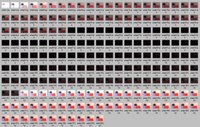 We tested our model by using our image with known illumination and scaling the values to produce new images with different illumination. We could then use these images to test the adaptation model and the time dependence. We used the images to create a sequence of images with different intensities. For the first 49 frames used the original image when the light source was 120cd/m2, resulting in 10-20 cd/m2. For the next 100 frames we divided the input with 100 to emulate that the light was turned off, this would equal the light from a candle. The last 50 frames were multiplied by 100 to emulate a new light source with 12000cd/m2. Looking at the picture it seems like we have a scaling problem, 12000 cd/m2 should equal a 10000w light bulb. This scene should be a bit brighter. See the figure 2 in appendix.
We tested our model by using our image with known illumination and scaling the values to produce new images with different illumination. We could then use these images to test the adaptation model and the time dependence. We used the images to create a sequence of images with different intensities. For the first 49 frames used the original image when the light source was 120cd/m2, resulting in 10-20 cd/m2. For the next 100 frames we divided the input with 100 to emulate that the light was turned off, this would equal the light from a candle. The last 50 frames were multiplied by 100 to emulate a new light source with 12000cd/m2. Looking at the picture it seems like we have a scaling problem, 12000 cd/m2 should equal a 10000w light bulb. This scene should be a bit brighter. See the figure 2 in appendix.Read the hole report

1 comment:
Post a Comment